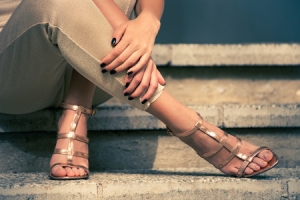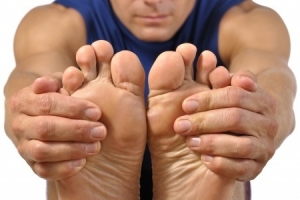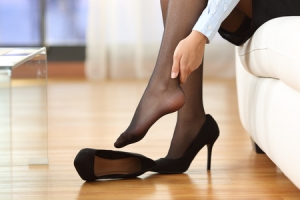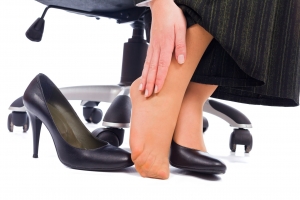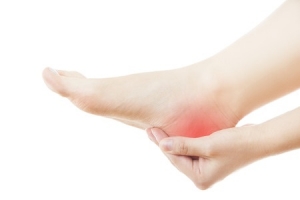Connect With Us
Blog
Displaying items by tag: Haglund's Deformity
Do You Like How Your Feet Look?
Are you comfortable wearing strappy sandals or open-style shoes? If not, does the appearance of your feet have something to do with it? At Superior Foot & Ankle Care Center, we know that several podiatric disorders have unsightly outward signs that can make female patients feel self-conscious about wearing individual shoe styles. Below are some of the most common ones and what you can do about them.
Bunions—a large bump at the base of the big toe is the telltale sign of a bunion. While many patients know how to recognize a bunion, there is a lack of understanding about the condition. A bunion is a progressive condition, meaning it will only get worse over time. That’s why at the first sign of a bunion it’s important that you make an appointment at our Long Beach office (562-420-9800) so that our podiatrists, Dr. Victoria M. Foley or Dr. Constance Ornelas can evaluate it. The foot doctor may want to take an x-ray to use to monitor the progression of the bunion. There are several conservative treatment options available, although only surgery can correct a bunion. The podiatrist will recommend the best treatment based on your individual case.
Haglund’s Deformity—perhaps you know this condition by its more common name—pump bump. A bony enlargement at the back of the heel distinguishes it. When pumps or other shoes with stiff backs rub against the bony protrusion, it can become inflamed and red, causing pain and discomfort. Wearing open-backed shoes and using heel lifts can both help reduce the irritation.
Fungal Toenails—a brownish discoloration of a toenail, along with thickening and crumbling edges can signal a fungal toenail. Although these are often not painful, they are unattractive and can spread to other nails if left untreated. Topical, oral, and laser therapy are all possible treatments for eradicating fungal nails.
You don’t have to hide your feet. If you have a condition that is causing you to want to keep your feet hidden away, contact us and let us help you restore your feet’s natural beauty.
4 Common Foot Problems for Men
June is a month for celebrating men! At Superior Foot & Ankle Care Center, we want to recognize Men’s Health Month by highlighting some foot infections that afflict men. Studies show that men are less likely to be proactive and diligent about getting medical care. Encourage the men you love to get foot problems treated promptly by our podiatrists, Dr. Victoria M. Foley or Dr. Constance Ornelas. Below are some common podiatric issues men face.
- Haglund’s Deformity—while this condition, known as “pump bump,” it frequently affects men as well as women. Haglund’s deformity is a bony enlargement at the back of the heel that can become inflamed and irritated from the friction of stiff dress shoes and other footwear rubbing up against it. Bursitis can also develop because of Haglund’s deformity. The foot doctor will recommend shoe modifications, including changes in style and heel lifts or pads to help reduce friction. Icing and anti-inflammatory medications may be prescribed to relieve initial pain and inflammation.
- Gout—this painful, arthritic condition that usually strikes the joint at the base of the big toe is seen most often in men, ages 40-60. It is caused by too much uric acid in the body, which crystallizes in the joint. There are several potential sources of gout, and the podiatrist will help men who have suffered a gout attack before tracking down the cause. In many cases, certain foods can trigger an attack, and gout patients may need to avoid shellfish, red meat, alcohol, and rich sauces.
- Fungal Infections—regular exercise is a key component of a healthy lifestyle, but if the gym or community pool is the work site of choice, it’s essential to keep feet covered to avoid fungal infections like athlete’s foot and fungal toenails. These are passed on by direct contact. Places where people usually are barefoot and that are moist and warm are prime breeding grounds.
- Plantar Fasciitis—one of the most frequent causes of heel pain is plantar fasciitis. The plantar fascia is a long band of tissue that stretches along the bottom of your foot. If it becomes inflamed, heel pain may result. Flat feet and poorly fitting or worn out shoes are one common cause of inflammation.
Encourage your man not to ignore foot and ankle pain. Instead, make an appointment at our Long Beach office today by calling: (562) 420-9800 and get treatment before the problem worsens.
Facts about Haglund’s Deformity
Are you familiar with the condition known as Haglund’s Deformity? At Superior Foot & Ankle Care Center we find that patients have some misconceptions about this disorder which affects the heel. Below are some facts to better familiarize you with this foot problem:
FACT: Haglund’s Deformity is a bony enlargement that develops on the back of your heel. Other signs of this condition are swelling and redness around the enlargement and pain where the Achilles tendon attaches to your heel bone.
FACT: Another name for Haglund’s Deformity is “pump bump.” That’s because pumps with their stiff backs hit the bony enlargement and irritate it, resulting in pain when walking and wearing shoes.
FACT: More women than men get Haglund’s Deformity.
FACT: Although pumps aggravate the bony enlargement, they are not the cause of Haglund’s Deformity. This condition is the result of structural defects, including overly high arches, the tendency to walk on the outside of your heel or a tight Achilles tendon.
FACT: Haglund’s Deformity can only be corrected by surgery. There are, however, a number of conservative measures that can be used to relieve pain and decrease pressure on the bony protrusion. After our podiatrists, Dr. Victoria Foley and Dr. Constance Omelas, examine your heel and order x-rays or other imaging studies to confirm a diagnosis of Haglund’s Deformity a treatment plan can be determined.
FACT: Treatment for pump bump will depend in part on the cause. Heel pads, for example, may be recommended if the cause is high arches or stretching exercises for your calf if the source of the condition is a tight Achilles tendon. Custom orthotics can also be used to correct abnormal foot motion.
FACT: Pain from pump bump can be reduced by icing the bony enlargement. Apply an ice pack wrapped in a thin towel (do not apply ice directly to the skin) for 20 minutes at a time with a 40-minute break in between.
FACT: You can help prevent inflammation of the bony growth by wearing shoes with open backs or those made of soft materials. You should also avoid running on hard surfaces and up hills.
If you have additional concerns about Haglund’s Deformity, contact our Long Beach office by calling: (562) 420-9800.
Shoe Choice Affects Foot Health for Women
At Superior Foot & Ankle Care Center we treat many women with foot problems that could have been avoided by choosing different shoes. Today, there are many attractive shoe designs that do not harm your feet. Short-term fashion choices can lead to long term foot health problems. Below are 3 types of shoes to avoid:
- High heels—shoes with high heels (2 inches or more) can cause a host of foot problems. First, the height of the heel can cause wobbling and instability which results in ankle sprains. High heels put extra strain on the muscles and ligaments of the ankle as they struggle to keep your foot in proper position. Continuing to wear high heels after a sprain is likely to set up a dangerous cycle of repeated sprains, increased weakness and eventually chronic ankle instability and pain. In addition, the design of high heels forces your toes forward, causing them to spend long hours cramped and squeezed. This increases the risk of bunions, hammertoes and other toe deformities.
- Stiff backed pumps—shoes with an overly hard heel counter can lead to a condition commonly referred to as “pump bump.” Officially known as Haglund’s deformity, a hard, bony enlargement forms on the back of the heel. When the back of pump rubs against the growth it causes irritation and inflammation. In some cases the bursa sac surrounding the deformity can become inflamed causing bursitis.
- Flip-flops—yes, these are comfortable and oh-so-easy to slip on and off but flip flops provide no support whatsoever for your feet. This increases the risk of your feet coming out of the shoe and getting cut or scraped and also the chances of twisting an ankle. The one exception to this is in gyms, public pools, spas and other places where covering your feet prevents contact with fungi and bacteria that can cause athlete’s foot, fungal toenail and
If a part of your foot, toe or ankle is causing you pain or you notice other symptoms such as bruising, swelling or redness, contact our Long Beach office for an appointment by calling: 562-420-9800. Our podiatrists, Dr. Victoria Foley and Dr. Constance Omelas will examine your feet and prescribe the correct treatment (in addition to changing your shoes) to relieve pain and prevent further injury.
Keeping “Pump Bump” Under Control
Pump Bump is the common name for Haglund’s Deformity. Many patients that we at Superior Foot & Ankle Care Center see with this condition mistakenly believe that it is caused by their shoes. In reality, the bony protrusion at the back of the heel is the result of faulty foot structure which is often inherited. Other conditions that can lead to pump bump include:
- Underpronation (walking on the outside edge of your foot)
- High arches
- Tight Achilles tendon
Reducing Pain and Irritation
Our podiatrists, Dr. Victoria Foley and Dr. Constance Omelas, will need to examine your foot to confirm a diagnosis of Pump Bump. The foot doctor will likely order x-rays of the back of the heel as well to evaluate the bone structure and rule out other conditions that might cause pain and irritation in that part of the foot.
Shoes with stiff backs that repeatedly rub against the bump make it red and painful. Pumps consistently hit the spot where the deformity is located and hence the name, Pump Bump. Other shoes are problematic also, including high topped work boots, ice skates and certain men’s dress shoes. If you have Haglund’s Deformity you obviously have to be selective about your footwear. A callus or open sore can form if you continue to wear shoes that put pressure on this spot.
There are several other ways to relieve the pain and decrease the friction on the bony enlargement, depending on what else is putting stress on the back of the heel. The foot doctor may recommend heel lifts to help compensate for high arches, stretching exercises if you have a tight Achilles tendon, or custom orthotics to help control the motion of the foot. Padding, immobilization and medication are other avenues of treatment. If you continue to be in severe pain despite these noninvasive measures, surgery may be required.
The bottom line is if you have Pump Bump you don’t need to continue to suffer. Make an appointment at our Long Beach office by calling 562-420-9800 and find out what can be done to relieve your painful symptoms.
Archives
Categories
- Featured (165)
- Blog (179)
- Ankle Care (6)
- Ankle Condition (2)
- Ankle Pain (0)
- Appointment Tips (2)
- Arch Pain (1)
- Arthritis (10)
- Athlete's Foot (6)
- Blister (1)
- Bunions (7)
- Calluses (1)
- Child Care (2)
- Circulation (1)
- Common Foot Conditions (4)
- Common Foot Problems (3)
- Corns (0)
- Custom Orthotics (1)
- Diabetes (10)
- Diabetic Foot Care (3)
- Diabetic Footwear (1)
- Edema (1)
- Exercise (4)
- Fall Prevention (1)
- Fitness (1)
- Flat Feet (2)
- Foot Care (19)
- Foot Care Safety Tips (3)
- Foot Care Tips (20)
- Foot Conditions (12)
- Foot Facts (3)
- Foot Health (6)
- Foot Odor (1)
- Foot Pain (5)
- Foot Problems (2)
- Foot Safety (1)
- Foot Surgery Tips (2)
- Foot Warts (2)
- Foot Wear (2)
- Fractures (1)
- Fungal Infection (2)
- General Health (0)
- Gout (5)
- Gout Treatment (0)
- Hammertoe (1)
- Health Tips (46)
- Heart Health (1)
- Heel Pain (0)
- Heel Spurs (0)
- Ingrown Toenails (4)
- Interesting Facts (2)
- Joint Pain (2)
- Leg Conditions (2)
- Leg Condtions (0)
- Men's Foot Health (1)
- Metatarsals (0)
- Nail Fungus (2)
- Neuropathy (1)
- Nutrition (2)
- Obesity (2)
- Osteoporosis (1)
- Pain Relief (5)
- Patient Communications (1)
- Pediatric Foot Conditions (5)
- Pediatric Foot Pain (2)
- Pedicure (1)
- Peripheral Arterial Disease (1)
- Plantar Fasciitis (2)
- Podiatrist Appointment (0)
- Pregnancy Feet (3)
- Proper Shoes (2)
- Senior Foot Care (7)
- Shoe Fit (1)
- Skin Cancer (3)
- Sports Injuries (2)
- Spring Foot Health (1)
- Summer Foot Health (2)
- Toe Pain (4)
- Uncategorized (5)
- Varicose Veins (2)
- Walking (1)
- Women Foot Health (3)
- Youth Sports (2)
